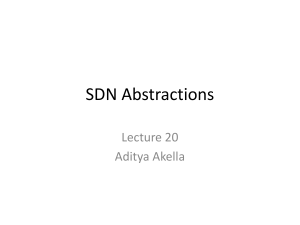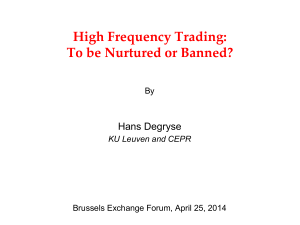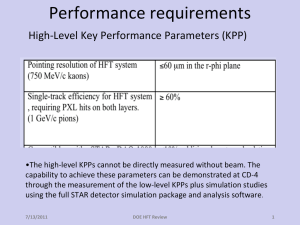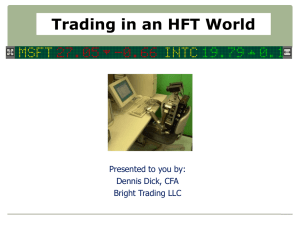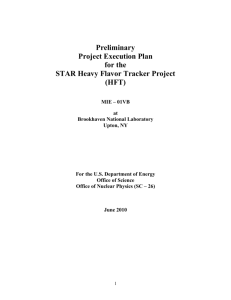High Frequency Trading Overview
advertisement
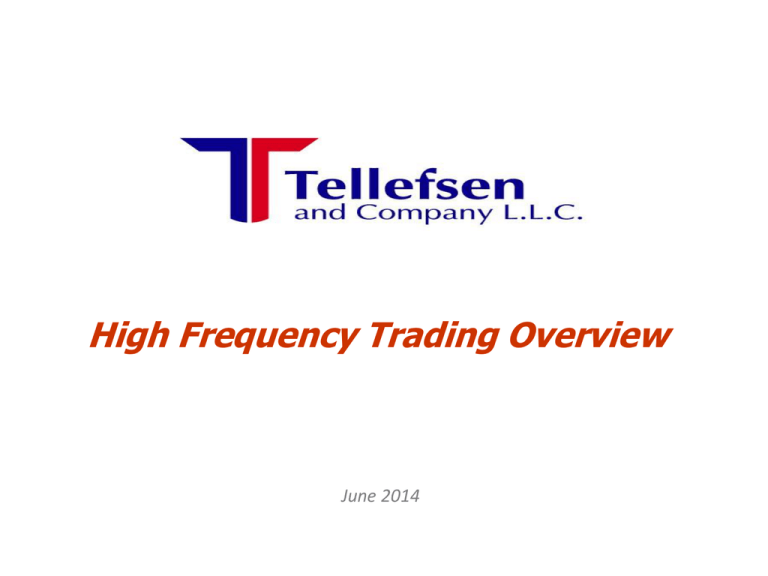
High Frequency Trading Overview June 2014 Intro • In response to the recent media hype surrounding Michael Lewis’ book “Flash Boys”, we have created this synopsis of high frequency trading (HFT) • The synopsis includes background from the unintended consequences of SEC’s Reg NMS, issues, the pros and cons of using ATS “dark pools”, an overview of HFT technology components • We also provide our views and opinions on HFT and where the industry is going. HFT Overview Background • Reg NMS (post decimalization) in 2005 requires exchanges and dark pool ATS to compete on price within the National Best Bid/Offer (NBBO) • Intended to create a level playing field between exchanges and dark pools, lowered the bid/asked spread • The concept of “fast markets versus slow markets”; created a racing effect • Most ATS dark pools created 2005-2007, post the implementation of Reg NMS • Price competition results in high rates of orders/cancels and routing away to other venues by HFT players, as the NBBO changes and they seek the best bids/offers • Ramped up since 2005, Reg NMS moved some responsibilities from specialists and market makers to buy and sell-side traders. HFT Overview Background (Cont’d) … • The “Law of Unintended Consequences” – Reg NMS created a highly fragmented market, potentially subject to gaming • Today there are 13 equity exchanges, 12 options markets and 45+ dark pool ATS, based on their liquidity and market share • The SEC has micro-managed Reg NMS regulations and compliance; they say that exchanges must treat the same classes of users consistently • Exchanges have become technology providers, and now offer proximity hosting (co-location) services as a new, premium priced service • There is a limited audience of HFT and DMM firms that can afford a “premium seat”; there has been consolidation as a result of lower transaction volumes, cost pressures have pushed the marginal players out of the market. HFT Overview Background (Cont’d) … • Exchange technology services have quickly evolved into profit centers • Co-lo services have fixed/variable costs (e.g., most co-lo contracts are ~24 months long) • Payment for order flow (PFOF) incentives by exchanges, potential conflicts with firms’ “best execution” responsibilities • But, best ex is not required for unsolicited, directed order flow to a specific venue • The impact of HFT on “informed” order flow versus “non-informed” order flow; resting order flow versus transitory flow. HFT Overview Issues • Connectivity to a growing number of execution venues adds cost, complexity and increased regulatory burdens to buy-side and sell-side firms • Preferencing of orders via smart order routing, algo logic. • Latency arbitrage opportunities – trading ahead of index re-balancing, economic/corporate news releases, social media “chatter”, event arbitrage, stat arb • Some platforms have more latency than others (e.g., the distance between firms, co-lo sites and the matching engine; matching engine design optimization; communications speeds/laws of physics) • Latency differences at trading venues between order entry/execution systems and SIP (central market data) reporting, result in opportunities for “latency arbitrage”. HFT Overview Issues (Cont’d) … • Gaming of orders, spoofing markets, layering of order methods to prevent/retard gaming (e.g., display names and size only, display names and side only); lock out the bad actors • Penny jumping, sweeping the book, sub-penny churn of ETF arbitrage and client order flow • Inconsistency in the controls used to manage the trading processes and procedures across the various venues • The business and technical ramifications of when things all go wrong at the same time: – Flash Crash 2010 – Knight Capital Rogue Algo, Incompatible Software – Hash Crash 2013 HFT Overview Issues (Cont’d) … • Potential for spikes in volatility if market makers cannot stabilize prices within the minimum spread • Need for well-developed processes and procedures, error account liability • Most of the low hanging fruit has already been picked! HFT Overview The Players • HFT firms include prop trading firms, Designated Market Makers (DMMs), buy-side and sell-side firms • Technology innovators, early adopters; followers and laggards • Prop trading firms – flow traders looking for an edge – Scalpers, day traders – Transitory order flow • “Like picking up pennies in front of a fast moving steam roller” • Many trade intra-day with high, intra-day VaR, low regulatory capital • Market making firms – have contractual obligations with exchanges – • Provide resting and transitory order flow Sell-side brokers – Agency order flow providers with resting order flow. HFT Overview The Players (Cont’d) … • Players have included Barclays, Chopper Trading, Citadel, DRW, Getco, Goldman Sachs, Instinet, Millennium, Morgan Stanley, RGM Advisors, Spot Trading, Sun Trading, UBS, Virtu Financial • As profitability has contracted, many have moved on from equities into other asset classes (FX, futures, emerging markets). HFT Overview HFT – Technology Components • ULLDMA Technologies: • Co-located servers, proximity hosting with exchange/ATS matching engines • Algos to slice and dice block sized orders, smart order routing to venue(s) with the prevailing NBBO or size liquidity – Subsets and core components of HFT • Ability to consume and digest a large volume and velocity of “big data” (structured and unstructured real time market data, news, social media chatter) • Evolution of new order types – • Variations on LMT, IOC, FOK etc. Use of high-speed networking, hardware and software technologies. HFT Overview HFT – Technology Components (Cont’d) … • Fiber network connectivity for speed advantages to address/mitigate and extract latency arbitrage • Evolution of microwave communications between east coast and midwest exchange co-lo sites for further speed edge • Specialized FIX connectivity to – ~50 equity exchanges/ATS dark pools – 8-10 futures exchanges – ~20 FX networks/ECNs • Specialized, continually-tuned software engineering and related tech architecture expertise • Capex requirements for equipment purchases • Build outs can take several months or longer. HFT Overview HFT Growth Rate* • Early 2000’s: <10% U.S. equities • 2014: ~73% of order flow volume *Source: New York Stock Exchange HFT Overview Decline in HFT Profitability, Downward Margin Pressures • Low volatility, declining transaction volumes; effects of de-leveraging, capital adequacy constraints on market making, prime brokerage activities • High barriers to market entry (capex expenditures, IT infrastructure investment, specialized trading, software engineering and tech infrastructure expertise) • Escalating IT and regulatory compliance costs • Profit margin decline from ~10 mils/share in 2008 to ~5 mils/share in 2013 • Getco’s HFT profit fell 90% in 2012/2011; they exited the HFT business in Feb 2013. HFT Overview Pro’s / Con’s of Dark Pools PROs • Multiple liquidity pools, places to source liquidity • Some offer anonymous block trading • Support for multiple, new order types to facilitate HFT • Gives buy-side traders more control, choices for execution • Preferencing of orders via algo routing to specific venues • Internalization of order flow: a smorgasbord of block, retail, institutional, prop, market making orders • Latency advantages/disadvantages between exchanges, ATS venues CONS • Internalization of order flow by large “wholesalers” • Levels of complexity and responsibilities for the buy-side in achieving Best Ex • Potential for information leakage and gaming • Latency advantages/disadvantages • Custom order types can become “toxic” • Payment for order flow • Some of the smorgasbord of order flow can be considered “toxic” HFT Overview Implicit / Explicit Trading Costs • Traditional slippage, market impact costs (latency) • Market impact costs in handling block flow versus retail/small order flow • Floor brokerage and commissions • Rebate fees • Exchange fees including the premium costs for proximity hosting of servers in co-lo sites • The impact of informed versus un-informed order flow • Transaction cost analysis (TCA) tools now available in the public domain. HFT Overview Maker/ Taker Fees, Ranges • Varies from venue to venue • Fees vary from the buy-side and the sell-side (i.e., some fees may not be passed along to buy-side, others are passed along to the sell-side) • Equities: • • – Makers: 0-15 mils/share – Takers: 15-40 mils/share Options: – Makers: 0-44 mils/contract – Takers: 10-50 mils/contract PLUS: – Routing fees of 25-50 mils/share HFT Overview The IEX Model • IEX ATS trades in strict price, time priority • FIFO matching within the mid-point of the NBBO • Book priority, broker priority (agency and riskless principal orders) • Does not offer co-lo services • IEX has a separate POP at Equinix hosting site • All users have the same cable lengths from their servers, regardless of rack location to the matching engine – for further fairness • The IEX Pricing Model: – No maker-taker fees – Charge a flat 9 mils to both sides – Adds 1 mil to whatever the receiving venues charges for routing to them HFT Overview Our Opinion • HFT firms exploited a loophole in Reg NMS, an unintended consequence, creating a technology arms race • Not all HFT is bad, but there have been some bad actors • Reg NMS, fueled by HFT, has resulted in compressed spreads, making it cheaper for retail investors in the long term • Market makers have had to embrace, adopt HFT technologies and business models to support their DMM obligations, defend their profitability and keep up with speed and tech arms race • Flash Crashes are fueled by HFT (like fire is by wind), and are caused by poorly tested/designed algos and lack of experienced trading professionals and operational risk procedures. HFT Overview Our Opinion (Cont’d) … • Most of the low hanging fruit has already been picked and HFT profitability is down • Few, if any new (prop) players are entering this market, due to the high barriers to entry • This racing effect produces questionably predictive profit seeking opportunities for prop trading firms. • Firms trading for the rebates will have to find a new way to make money (or exit the business), as maker-taker and taker-maker business models will be under heavy regulatory scrutiny; exchanges may be forced to greatly revise or scrap them • We believe there are, at best, ~36 prop trading firms that are making money at HFT today. HFT Overview Our Opinion (Cont’d) … • The Flash Boys controversy, media hype has global regulators taking a closer look at the markets, HFT business and the players • Shifting regulatory reform of HFT will impact exchanges business models and grind into their cost structures, as co-location and takermaker revenues compress • Co-lo hosting providers, communications and related HFT services providers will also be impacted by regulatory changes. HFT Overview For More Info on HFT Directions: Tellefsen and Company, L.LC. 1-212 809 3800 JJR@Tellefsen.com HFT Overview 22


